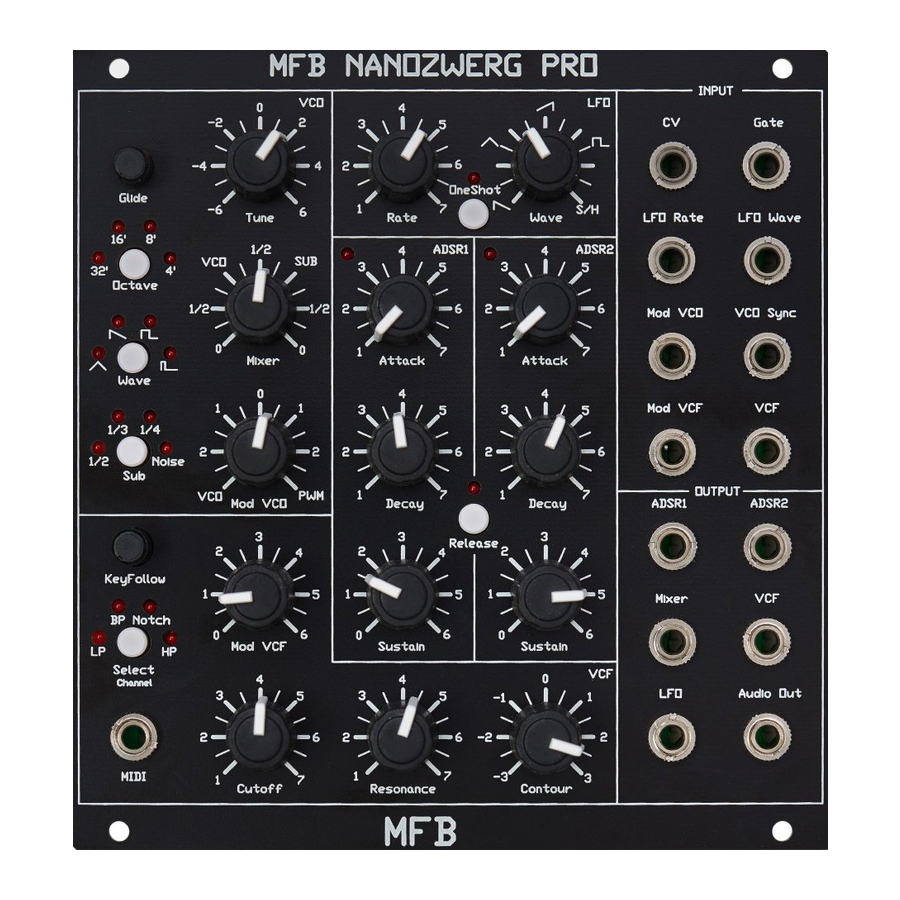
MFB NANOZWERG Pro - Synthesizer Manual
- User manual (2 pages) ,
- User manual (2 pages)
Advertisement

General
The NANOZWERG is a monophonic, analogue Synthesizer module, which in its Design, BUS-Power and CV/Gate-Voltage is fully compatible to a Doepfer A-100 Modular system. Most of the Audio-Parameters can be addressed externally by using the CV-Inputs. In addition, this is also possible by using Midi or M-Bus. The Module contains all typical elements of subtractive Synthesis and can be used for Bass-and Lead sounds as well for Effect noises or as a Filter box.
Set-Up
Connect the 10-pin cable to the corresponded 16-pin jack on the Doepfer mainframe bus or the MIDI/CV circuit board. Supply voltage needs to be +/- 12 volts, 5-volt connections are not required. The wattage is ca. 150 mA. The Modulesize is 24 TE = 121,9 mm.
ATTENTION: Please, check for correct polarity! The colored side of the connector-cable needs to point downwards so that the cable is not twisted.
Advice: The NANOZWERG is an analogue Synthesizer module therefore it is recommended to run for 10 min. after turning it on to „warm up", to ensure solid tuning.
Oscillator-section (VCO & Sub OSC)
NANOZWERG features one VCO with an additional sub-oscillator. The VCO offers four Waveform shapes, which can be selected by pressing Wave: triangle, saw tooth, rectangle and impulse. Octave sets the base octave to 16', 8', 4' or 2'. Tune controls the tuning within a Range of +/- one octave.
The sub-oscillator generates a rectangle-wave one - two octaves below the VCO tuning. Press Sub OSC to toggle in between the settings 1/2, 1/3, 1/4 or Noise. Alternatively the rectangle signal can be replaced as a noise-generator. Mixer adjusts the balance between VCO and SubOSC/Noise.
Use VCF In to use any external audio-signal instead of the sub-oscillator.
The VCO can be modulated by the LFO. By turning Mod VCO to the left, the pitches of VCO and Sub Osc are modulated. Turn it to the right and it will adress the symmetry (pulse width) of the impulse-waveform. If its in middle position, Modulation will be deactivated. Alternatively instead of the LFO you can use Mod VCF In for modulation. The VCO can be synced by using the VCO sync input.
Glide
The trim controller Glide sets the length for a continuously glide of sequently played notes. (Portamento)
Filter-section (VCF)
The 12-dB-Multimode filter allows sonic shaping of oscillator, sub-oscillator and the external audio-input.
It offers four modes, selectable by pressing Select: low-pass (LP), band-pass (BP), Band Reject (Notch) and high-pass (HP).
The Cutoff frequency is adjusted using Cutoff. In addition this parameter can also be controlled by different sources. The trim pot Key Follow sets the dependency between cutoff and incoming notes on the MIDI-or Key CV-Input.
Contour adjusts the control of the ADSR-Envelope 1 towards the cutoff frequency. Turning it to the right has a positive influence, while turning it to left has negative influence. By turning the knob into the centre modulation will be turned off.
Mod VCF introduces a continuous modulation to the cutoff-frequency through the LFO.
Mod VCF In CV is a CV-input, which for example, can be addressed by a step-sequencer.
Resonance sets the emphasis(Q-factor) of the filter at the current Cutoff-frequency. At its maximum self-oscillation can be reached.
Amplifier (VCA)
The final part in the Signal path is a voltage-controlled amplifier. The VCA is triggered by the ADSR-Envelope 2. The output signal goes out on Audio Out.
Envelopes (ADSR 1 + 2)
The envelope generator offers control for Attack-time, Decay-time, Sustain-level and Release-time. Release does not own its own knob, but can be set by the Decay-knob or has a fixed release time. Pressing the Release-button can choose these two modes. Is the LED turned off is the release–time fixed. The first three phases work while one note at the MIDI-or Gate-input is active. The release-time starts after gate/note-signal has been stopped. The envelope can be used external by using ADSR1 Out and ADSR2 Out.
Modulation-oscillator (LFO)
The LFO offers four waveform shapes: triangle saw tooth, rectangle and S/H (Sample & Hold). The first three waveforms can stepless be switched by using the knob Wave. Rate sets the LFO's frequency (speed) between approx. 4 seconds to ca.150 Hz. Both Parameters can be changed through CV by using the inputs LFO Rate In and LFO Wave In. OneShot activates a one-pass-mode, where the selected waveform is only played once, after a note-trigger input is received.
MIDI/M-Bus
NANOZWERG receives MIDI-Notes over a range of five octaves (C1-C6). In addition it accepts MIDI-Data for Pitch Wheels (+/-1 Semitone.). All Parameter can be controlled external via Midi-controller The Midi Implementation can be seen in a separate document. For the M-Bus there are two jacks on the bottom of the backside. One is connected to an M-Bus-Output the other one to the next M-Bus-capable module. If the M-Bus is plugged, Midi is turned off.
MIDI-Channel
To select a MIDI-Channel press Select of the Filter for ca. 2 Seconds till the Filter LEDs run in a circuit. NANOZWERG is now waiting to receive the next Midi note and takes over its channel. This also applies for the M-Bus.

Documents / ResourcesDownload manual
Here you can download full pdf version of manual, it may contain additional safety instructions, warranty information, FCC rules, etc.
Advertisement











Need help?
Do you have a question about the NANOZWERG Pro and is the answer not in the manual?
Questions and answers